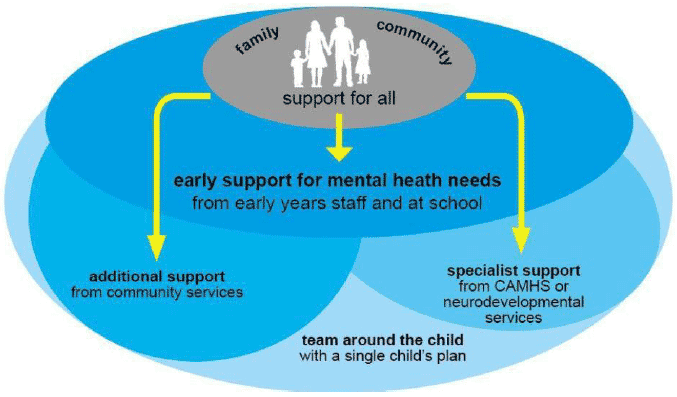Community mental health and wellbeing supports and services: framework
This framework sets out a clear broad approach for the support that children and young people should be able to access for their mental health and emotional wellbeing within their community.
Context
1. This framework specifically addresses establishing or developing community supports and services that target issues of mental and emotional distress and wellbeing rather than mental illness and other needs that may be more appropriately met through CAMHS. It supports an approach based on prevention and early intervention.
2. This framework is intended to be used to help partnerships to design and build services and supports that are in line with GIRFEC, national priorities and principles, relevant to local developments and are based on local needs assessment, responsive to the needs of local communities.
3. Children, young people and their families should receive the support they need, when they need it, underpinned by the values, principles and components of Getting it Right For Every Child (GIRFEC), and responsive to local needs and systems. This should support and improve their mental health and emotional wellbeing and be provided by people with the right knowledge, skills and experience to support them. GIRFEC is:
- child-focused - it ensures the child or young person and their family is at the centre of decision-making and the support available to them;based on an understanding of the wellbeing of a child in their current
- situation - it takes into consideration the wider influences on a child or young person and their developmental needs when thinking about their wellbeing so that the right support can be offered;
- based on tackling needs early - it aims to ensure needs are identified as early as possible to avoid bigger concerns or problems developing;
- requires joined-up working - it is about children, young people, parents, andthe services they need working together in a coordinated way to meet their specific needs and improve their wellbeing.
4. The whole system model recommended by the Taskforce, involves both 'early support for mental health needs' and 'additional support from community services'. It recognises that there should be continuity in support around the child or young person. This framework is designed to enhance the development of servic es and supports that occupy the 'additional support' aspect of the Taskforce's vision. It is essential that additional support from community services is well integrated into the whole system with strong links with the early support provided by universal services and with specialist supports.

Diagram description:
CAMHS Services within the agreed Children and Young People’s Mental Health and Wellbeing model showing that the team around the child includes additional support for community services, specialist support from CAMHS or neurodevelopmental services, early support from early years and school, and the family and community.
5. This framework recognises that the current range of provision is variable across all local partnerships and that whilst there is much to build on, the full range of supports and services described in this framework will not be available across the age range in any area. The focus is therefore on the additionality that is required to ensure that a continuum of support and services is in place. The framework sits alongside Scottish Government funding intended to resource that additionality and support Community Planning Partnerships or Children's Services Partnerships, in order to deliver more sustainable, effective and easily accessible community supports and services to address mental and emotional wellbeing.
The framework sets out expectations for the kind of support that should be in place in every local area to ensure that no child or young person is left with nowhere to turn. It recognises the rights that children, young people and their families have to easily access consistent, sustained local support across Scotland, as part of our commitment to embedding Getting it right for every child (GIRFEC) which reflects the principles of the UN Convention on the Rights of the Child (UNCRC).
6. Through Children's Services Partnerships or Community Planning Partnerships, education, health including CAMHS and primary care, wider children's services, youth work and the third sector will work together taking a whole system approach to supporting children, young people and their families. Children and young people should experience a seamless pathway through supports.
7. These services and supports should initially focus on the 5-24 (26 for care experienced young people) age range. We are also committed to establishing an integrated infant mental health service to provide parent-infant relationship support for infants where there has been disruption to the parent/infant relationship.
8. Children's Services Partnerships or Community Planning Partnerships should work with children, young people and families in their communities to develop supports and services which are new or which build on existing effective support, where that exists, are appropriate and increase the opportunities to improve their mental health and emotional wellbeing, covering an age range of 5-24. It is likely that to cover the full age range and other requirements, local children's services partnerships or community planning partnerships will utilise a combination of supports and services some of which will be new and some of which will be enhanced.
9. We would anticipate that families and carers of any child or young person receiving support (from CAMHS, school, community supports or elsewhere) are also supported.
10. Local partnerships are also asked to clearly identify how community services and supports will be co-produced with children, young people and their families.
Contact
Email: neil.guy@gov.scot
There is a problem
Thanks for your feedback